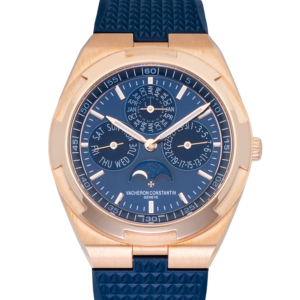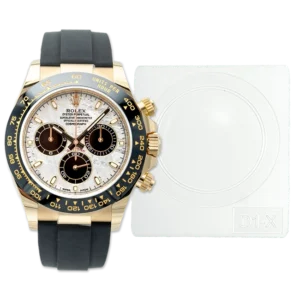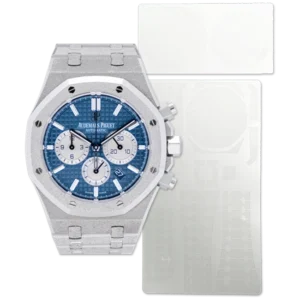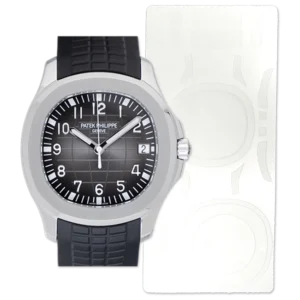MAKE AN APPOINTMENT TO VISIT OUR STORE
There are good watch brands, great watch brands and then there is the ‘Holy Trinity’.
The name given to the trio of manufactures which occupy the very highest echelons of watchmaking, the Trinity is made up of three marques of absolute distinction and unsurpassable pedigree.
Patek Philippe and Audemars Piguet take two of the spots. The third belongs to fellow Swiss luminary, Vacheron Constantin.
Recognized today as the oldest continuously operating brand in the world, Vacheron Constantin’s timepieces are exemplified by their impeccable craftsmanship, staggeringly intricate complications and their under-the-radar persona—not as universally recognized as the likes of Rolex or even Patek, Vacheron is the choice of the most knowledgeable collecting elite.
Today, their portfolio continues to be a place of constant innovation, drawing on expertise gleaned from more than 250-years in the business and where the best of old world aesthetics blends with the latest in contemporary technology.
Below, we take a look through Vacheron’s long history and find out what has kept them at the very top all these years.
Vacheron Constantin History
The brand can trace its roots all the way back to 1755. That is the year a young 24-year old, Jean-Marc Vacheron, established his fledgling company in Geneva. He set up shop in the Saint-Gervais district working in the ‘Cabinotiers’, small workshops usually on the top floor of a house which were flooded with natural light. The Ateliers Cabinotiers still produce exquisite watches even today.
Vacheron took the unusual step of employing an apprentice and together they set to work manufacturing custom-made, high quality pocket watches for a clientele which included royalty and other notable citizens from all over the world. Louis XIV of France, Czar and Czarina Alexander II of Russia and the New York financier, Henry Graves Jr. were all in possession of Vacheron pocket watches.
In 1785, Abraham Vacheron, Jean-Marc’s son, took over the business, just four years before the dawn of the French Revolution. The rising up of the country’s proletariat against the aristocracy obviously took its toll on the luxurious products of the watchmaking industry, but Abraham was able to navigate the troubles and keep his company in existence.
His own son, Jacques Barthélémi, inherited the business in 1810 and he began to produce more complicated watches, such as musical pieces which were able to play two melodies. A few years later, he joined with a successful businessman in Geneva named, Francois Constantin, renaming the maison Vacheron & Constantin in 1819.
The combined expertise of this new partnership meant they were able to expand their client base into Europe and the Americas, and the brand flourished.
Vacheron Constantin Through the Years
By the mid-19th century, demand for Vacheron & Constantin watches had grown to such an extent that demand far outstripped supply. Hampered by aging technology and having to construct every watch by hand, the company’s technical director, Georges-Auguste Leschot set about automating as much of the process as possible. He developed on Scheiner’s invention of the pantograph, adapting it to work as a milling machine rather than a design tool, along with devising other new instruments which allowed serial production and the manufacturing of interchangeable parts. With these processes supplementing the manual work, the assembly and marketing of VC’s products accelerated greatly.
In 1880, the brand adopted the Maltese Cross as their logo, and it appeared on every watch created by the brand from then on. As well as a strong image, its shape is reminiscent of the movement component which regulated the tension of the mainspring. It remains in use today.
The First Wristwatches
Vacheron Constantine started producing wristwatches as early as 1888. A huge break from the status quo, they were soon in demand in the most fashionable metropolitan areas all over the world.
The company entered something of a golden age and in 1903, now under the leadership of George Grandjean following the death of Francois Constantin, they were commissioned by the Wright brothers to build a portable timepiece to be used aboard their revolutionary biplane, the Wright Flyer. VC obliged with one of the first examples of a pilot’s watch, a robust model with a chronometer-rated manually winding movement.
Sadly, the outbreak of WWI saw the end of the company’s most prosperous period. Demand for their products disintegrated and many of the firm’s workers were conscripted for the frontline anyway. The manufacture was kept afloat by large orders from the USA, the country entering hostilities in 1917 and needing military watches for the American Expeditionary Forces. VC became the main supplier
Even after the war the situation barely improved, with heavy import restrictions put in place to prevent much needed capital from leaving the country during its rebuilding efforts. It would take until 1922 before the brand experienced any sort of significant turnaround.
But it wouldn’t last for long. The stock market crash of 1929 plunged Vacheron into its darkest days so far.
Vacheron Constantin in the 20th Century
Black Friday, October 29th 1929, signaled an era of massive decline in both production and orders. Even commissions from the likes of King Fuad I of Egypt, who received an 18-carat gold pocket watch featuring a double calendar chronograph, alarm, minute repeater and Grande and Petite sonnerie, only delayed the inevitable.
The company was forced to issue mass layoffs, and steel and silver cases started to replace the previous gold pieces in order to keep costs down.
The downward spiral lasted until 1938, when VC entered into an agreement with Jaeger-LeCoultre. LeCoultre would supply ébauches to Vacheron, who would, in turn, promote JLC watches.
The partnership proved a successful one.
Modern Times
With times improving, Vacheron Constantin were freed up to produce some truly groundbreaking timepieces.
In 1946, King Farouk I of Egypt took possession of the ‘La Farouk’. Featuring an alarm clock, split-seconds chronograph, astronomical perpetual calendar with moon phases and minute repeating grande et petite sonnerie, the piece needed 13 hands to display all its information and contained a movement comprised of 820 parts. Measuring 80mm in diameter and crafted from 18-carat gold, it was one of the two most complicated pocket watches made by VC in the entirety of the 20th century.
Other highly significant breakthroughs were to follow. In 1955, the brand’s 200th anniversary, they launched the Jubilee 6099, officially the slimmest wristwatch in the world. Inside was another record-breaker, the Caliber 1003. A manually-wound, time-only mechanism, it was the smallest movement ever made at just 1.64mm high and 21.05mm in diameter.
In the 1970s, in the grip of the quartz crisis, they produced the Kallista, then the world’s most expensive wristwatch. Containing some 130-carats of precious stones, it took over 6,000 hours to build and sold for $5m to, as the rumors have it, the Sultan of Brunei.
Vacheron was taken over by the Richemont Group in 1996 (then the Vendôme Group), coming up with enough funds to build all-new premises in Geneva and starting the brand along the road to becoming a fully-fledged manufacture. They produced their first in-house movement in 2000, the Caliber 1790, followed by the hand-wound Caliber 1400. Since then, more homegrown calibers have emerged, elevating the status of the brand still further.
Most recently, perhaps VC’s greatest triumph to date came along in 2015 with the release of the incredible 57260, still the most complicated timepiece in the world. Its 57 complications and 31 hands are powered by a movement containing 2,826 parts, in a pocket watch weighing 957 grams. The result of eight years of planning and building, it holds 10 patents and was the subject of 85 separate prototypes. Just the drawings and diagrams needed to complete the watch reportedly weighed 16kg! It was sold to a ‘major watch collector’ for an undisclosed sum believed to be in excess of $10m.
Vacheron Constantin remains buoyed by their slogan, coined all the way back in the early 19th century by François Constantin, ‘Do better if possible, and it is always possible’.
The brand has been one of haute horlogerie’s major players for well over two centuries now. Their litany of past innovations and their breathtaking contemporary catalog has ensured their reputation continues to proceed them, and the respect with which their name is spoken in the industry is suitably reverential.
A true watchmaking heavyweight, they remain as fascinating and relevant today as they have ever been.
The Vacheron Constantin Collections
There are a total of 10 collections in the modern VC portfolio:
The Patrimony Collection: Simple, restrained and beautifully slender, the Patrimony collection is pure elegance and subtle class
The Traditionelle Collection: A range that runs the gamut from straightforward timekeepers through to exceptionally complicated, the Traditionelle collection is a diverse series of watches, all housed in sumptuously round cases
The Fiftysix Collection: The entry level series, the Fiftysix collection is a more laidback, casual family of watches with a versatile aesthetic
The Overseas Collection: VC’s travel collection, the Overseas range, includes dual time zone and world time models, all in cases inspired by the brand’s Maltese Cross logo
The Égérie Collection: A new collection of ladies watches, the Égérie collection is made up of gemstone-infused pieces with distinctive off-centered sub dials
The Historiques Collection: A vintage-inspired collection, Historiques draws on VC’s long and storied legacy to bring a range of imaginative reinterpretations of classic past references
The Métiers D’Art Collection: A series which celebrates the variety of decorative arts used in jewelry and watchmaking, the Métiers d’Art collection features stunning pieces inspired by the Chinese zodiac and great explorers
The Heures Créatives Collection: A ladies collection drawing on Vacheron Constantin’s watches from the Art Deco and Nouveau eras of the 1920s and 1930s. Epitomized by feminine curves and precious stone accents, they are a tribute to a glamorous age
The Malte Collection: A unisex range of pieces, all featuring a distinctive tonneau-shaped case and taking inspiration from VC’s long held Maltese cross logo
The Harmony Collection: Launched in 2015, the Harmony is a cushion-shaped piece with a curved middle case, square bezel and round crystal. Its form taken from a 1928 chronograph from the maison, it features a pointer date complication, twin calendar displays and a moonphase
How Much is a Vacheron Constantin Watch?
Vacheron’s standard lineup contains just short of 200 watches, covering a range in pricing from $12,300 for the Fiftysix Self-Winding, all the way up to around $726,000 for the Traditionnelle Grandes Complications, 80172/000P-9505.
In addition, there are a number of limited edition pieces which go far beyond that. The aforementioned Kallista, for instance, recently resold at auction for $11m.
As for the preowned and vintage market, here too are watches covering just about every price point. At the lowest end, you can secure a classic time-only wristwatch from the mid to late 20th century for as little as $2,500. While some of the more contemporary, extremely complicated models are comfortably into six figures and even higher.
Some ‘as new’ watches can actually be had for less than their official price by going through an unauthorized dealer. The Historiques Cornes de Vache 1955, to take one example, retails for $73,000. Yet as a preowned buy, that can drop to as little as $63,000 for this year’s model.
Who Wears Vacheron Constantin?
Unlike many luxury watchmakers, Vacheron Constantin doesn’t use celebrity ambassadors, preferring instead to let their watches do the talking for them. However, that doesn’t mean you won’t find them on the wrist of some of the most famous and influential people, literally of all time. Below, is a list of just some of VC’s most illustrious patrons:
Napoleon Bonaparte (yes, really!), Harry Truman, the Wright Brothers, King Farouk I of Egypt, the Sultan of Brunei, James Ward Packard, Henry Graves Jr., Alexander Skarsgard, Larry King, Charlie Sheen and many more.









